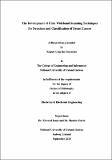| dc.contributor.advisor | Jones, Edward | en |
| dc.contributor.advisor | Glavin, Martin | en |
| dc.contributor.author | Conceicao, Raquel | en |
| dc.date.accessioned | 2011-04-11T16:13:06Z | en |
| dc.date.available | 2011-04-11T16:13:06Z | en |
| dc.date.issued | 2010-09-30 | en |
| dc.identifier.uri | http://hdl.handle.net/10379/1821 | en |
| dc.description.abstract | This thesis addresses the development of imaging techniques for the early detection of breast cancer, based on Ultra Wideband (UWB) radar, a promising emerging technology that exploits the dielectric contrast between normal and tumour tissues at microwave frequencies. Of particular interest in this work are issues related to the optimisation of UWB system design, as well as techniques for classification of potential breast tumours into benign and malignant. This is particularly important given the results from recent studies of the dielectric properties of breast and tumour tissue, which have found that strong similarities exist between the dielectric properties of malignant, benign and normal fibroglandular breast tissue. This creates a more challenging imaging scenario and motivates the development of enhanced signal processing techniques for UWB imaging systems.
The issue of antenna configuration for UWB imaging systems is examined in this thesis through a detailed comparison of two antenna configurations (i) planar, and (ii) circular. UWB signals are simulated by means of the FDTD technique, and the backscattered signals recorded from each antenna configuration are processed by means of a beamformer in order to create UWB images of backscattered energy. The performance of each antenna configuration is evaluated by both quantitative methods and visual inspection, for a number of test conditions.
Tumour growth and development patterns are modelled using Gaussian Random Spheres, using four discrete sizes and four different shapes. Feature extraction methods including Principal Component Analysis (PCA), Independent Component Analysis (ICA) and Discrete Wavelet Transform (DWT), are used to extract the most relevant features from the detailed Radar Target Signatures of the tumours, which are then classified with a number of different classification techniques: Linear Discriminant Analysis (LDA), Quadratic Discriminant Analysis (QDA) and Support Vector Machines (SVM). In addition to these techniques, a number of different multi-stage classification architectures are considered. The feature extraction and classification algorithms are evaluated for both homogeneous and heterogeneous breast tissue models, for a range of different tumour sizes and shapes. | en |
| dc.rights | Attribution-NonCommercial-NoDerivs 3.0 Ireland | |
| dc.rights.uri | https://creativecommons.org/licenses/by-nc-nd/3.0/ie/ | |
| dc.subject | breast cancer detection and classification | en |
| dc.subject | ultra wideband radar | en |
| dc.subject | microwave imaging | en |
| dc.title | The Development of Ultra Wideband Scanning Techniques for Detection and Classification of Breast Cancer | en |
| dc.type | Thesis | en |
| dc.contributor.funder | Science Foundation Ireland | en |
| dc.local.note | Raquel Conceição graduated in 2007 with a Masters in Biomedical Engineering at the Faculdade de Ciências e Tecnologia in Universidade Nova de Lisboa. She has completed her PhD in Electrical & Electronic Engineering in the National University of Ireland Galway in 2011. Her project involved the development of signal processing of Ultra Wideband signals for the early detection and classification of breast cancer. | en |
| nui.item.downloads | 7687 | |


